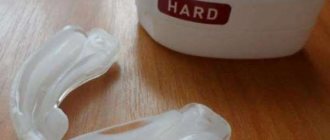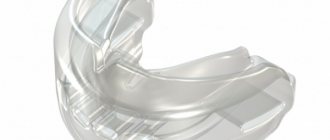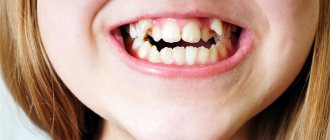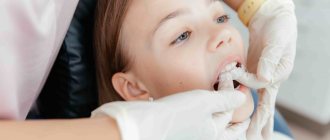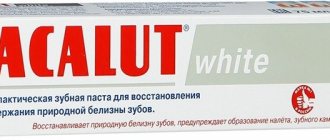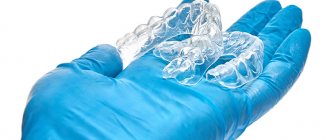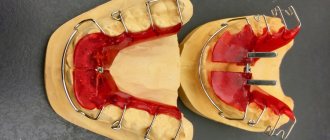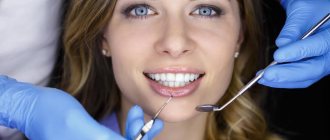Trainers for teeth is a type of myofunctional corrector that is used to correct bites along with classic plates and braces that are already familiar to everyone. The main feature of trainers is that they not only remove the consequences - they correct incorrectly formed teeth, but work with the cause: they help develop the jaw muscles, remove excess pressure on the bones, form correct nasal breathing, and tongue position. That is why this method of treatment is considered more promising.
Indications for the use of dental trainers
A dental trainer is usually prescribed to be worn in the following situations:
- a person cannot have braces installed for one reason or another;
- the bite has formed incorrectly;
- swallowing is impaired;
- teeth are displaced;
- often stuffy nose due to problems in the oral cavity;
- complexes or profession do not allow wearing other systems;
- there are speech therapy problems, etc.
Sometimes, if a doctor sees that a patient is at risk of malocclusion, he will prescribe a dental trainer as a preventive measure.
Read in detail about problems with bite here: All about bite: what it is like
Cost of dental trainers
The price of dental trainers is much lower than installing braces or surgical treatment. The amount varies from 2000 to 6000 rubles. Before using the device regularly, you will definitely need to consult a specialist, which can be done in a private office or clinic.
Dental trainers should only be used regularly if prescribed by a doctor. The specialist will determine a list of physiological disorders and also assess the prospects for treatment.
This article is for informational purposes only, please consult your doctor for details! Ask your doctor about contraindications and side effects.
Who should not wear trainers?
The systems described are primarily medical devices, so if you are impressed by the various photos before and after the trainer and want to buy such a device for yourself, be sure to consult with your doctor. Self-treatment with a trainer is dangerous and can cause harm.
There are other situations when it is better to choose another treatment option:
- if there is nasal congestion, which has become chronic (the patient simply will not be able to train at full strength, because he will have breathing problems);
- when the bite of the teeth in the lateral areas is cross;
- if a trainer is chosen for a child , but the child is uncontrollable and does not obey his parents (classes must be on schedule, otherwise there will be no effect).
In the described cases, it is better to use braces to correct a malocclusion.
Pros and cons of treatment with trainers
Why are dental trainers for adults and children so popular? This system has many advantages that make it popular and convenient. The main advantages of treatment using such structures:
- low price. The most budget trainer is very cheap, and modern improved models still cost 3-4 times less than an inexpensive brace system;
- ease of care. The patient does not require any special cleaning products or devices - just toothpaste and a brush are enough;
- versatility. The trainer does not need to be made specifically taking into account the patient’s characteristics; you just need to choose a model by size;
- wearing does not have a negative effect on the enamel or soft tissues, the devices do not injure the tongue or gums;
- In addition to bite, trainers also solve other problems, for example, correcting speech (in cases where diction problems were caused by incorrect dentition);
- the patient experiences minimal discomfort while wearing.
An additional advantage of trainer systems is that they do not cause any psychological discomfort: the trainer can be removed at any time to eat, drink or go to an important meeting. However, this method of changing the bite also has its disadvantages:
- slow effect. You need to wear the trainer for at least a year to see real results;
- prohibition on eating and drinking while wearing. If you take a trainer for a child , this can become a serious problem;
- Treatment must be carried out strictly according to schedule and for the required amount of time per day, otherwise there will be no effect. This option is only suitable for responsible people, and children should be supervised by parents.
Trainer effect: before and after
Indications
Elastic positioners eliminate bad habits: they wean children from sucking fingers, biting nails, and grinding their teeth. But most often they are used in orthodontics to treat various dental pathologies. These include:
- crowding of teeth, characteristic of the period of replacement of primary molars with molars;
- deep bite, accompanied by improper closure of teeth;
- speech defects;
- wide interdental gaps;
- mouth breathing in a child;
- curvature of incisors and canines;
- abnormal bite (when closing, half of the upper and half of the lower rows overlap).
A dental trainer for correcting dental defects is used instead of a brace system if a person is allergic to metal.
Types of dental trainers
Modern trainers for teeth straightening are classified according to different criteria. There are soft models, products of medium and high hardness. Each type is created for its own case. For example, an initial trainer is a soft structure that is used for treatment in the first stages, and a retainer is a model that allows you to consolidate the results of previous treatment. Let's look at the most popular types of trainers for dentition correction.
Pre-orthodontic children's trainers
Dental trainers for children are called pre-orthodontic and are used on the primary dentition. They are divided by age: for small children it is recommended to buy the Infant model (4-6 years old), for children from 6 to 10 years old there is already a more adult model - T4K, which takes into account the change of milk teeth to permanent ones.
Trainer Infant
A children's trainer is sometimes used even if there is no malocclusion. It is prescribed in the following cases:
- mouth breathing;
- increased tone of the temporomandibular joint;
- bad habits that negatively affect the dentition (for example, thumb sucking in your sleep);
- asymmetrical teething, etc.
The first trainer - the initial one - is made of soft silicone, which adapts to the child’s oral cavity. It is left overnight and used for 8-9 months. The second trainer – therapeutic – has a rigid frame and is installed for a year or more. Sometimes a child has to wear the system until he is two years old.
There are also special children's dental trainers that help avoid malocclusion in the event of early loss of primary incisors, canines, and molars. They are prescribed from the age of 3 years for the entire period while permanent teeth are being cut.
Finish Trainers
A final orthodontic dental trainer or retainer is usually prescribed for adolescents between 10 and 13 years of age. It is used for several purposes:
- consolidate the result after treatment with braces or other methods;
- allow weakened enamel to recover faster by protecting it from bad habits;
- form correct swallowing, reduce increased tone of the facial muscles.
Doctors often use a finishing type trainer to correct the not entirely correct position of teeth after unprofessional installation of a brace system.
Finish Trainers
Joint trainers
A joint trainer or joint splint is a device that reduces or eliminates pain due to dysfunction of the temporomandibular joint (TMJ) and relaxes tense muscles of the face and neck. At the same time, it also protects your teeth if you or your child have a habit of grinding them in their sleep.
Thanks to its arc shape, the articular trainer corrects the position of the lower jaw, and the soft material allows the device to easily adapt to any characteristics of the patient.
Joint trainer
Trainers for braces
A trainer for braces is a special type of medical device. It allows you to combine the stages of instrumental and functional treatment, increasing the effectiveness of both approaches. As a result, the result of treatment with braces becomes more stable, and the process itself goes faster.
Benefits of wearing a braces trainer :
- helps relieve muscle pressure;
- protects the oral cavity from damage from braces during the night;
- eliminates bad habits, which reduces the risk of re-developing dental problems.
Examples of such devices can be viewed in our catalog: Trainers for braces
Trainer for braces
Trainers for adults
Trainers for adults are used less frequently, but are also quite popular. The structure of the models is very similar to teenage ones, but a little more complicated. A standard hard trainer for an adult consists of the following elements:
- lip bumper, which reduces the tone of the facial muscles;
- a central stop that sets the correct position of the tongue;
- enlarged lateral edges, due to which the temporomandibular joint is supported.
Products are also divided by hardness: at night a soft model is used, and during the day it is recommended to train with a hard one.
An additional advantage of trainers for adults is that they successfully combat snoring.
Trainer for adults
Construction of simulators for teeth straightening
The first dental trainers were invented just over 20 years ago by the Australian company Myofunctional Research Co. Exercise machines are made from polyurethane and silicone and come in soft (blue or blue) and hard (red or pink).
Externally, they look like mouth guards for the upper and lower jaws, which consist of:
- recesses for teeth;
- lip bumper;
- labial arch;
- internal tongue stop;
- marker tongue.
The trainers have a universal shape, so when installing them there is no need to additionally take impressions and waste time on the production of an individual device.
The devices correct the bite gradually and almost imperceptibly.
Why trainers are better than other orthodontic devices
Compared to other orthodontic devices, teeth straightening trainers benefit in three ways:
- They do not need to be worn constantly like braces. Therefore, you don’t have to limit yourself in communication or refuse to work with people. At school, children will not suffer from ridicule from classmates;
- they do not put pressure on the teeth. Braces and plates affect the teeth, destroying the enamel and injuring, irritating the mucous membrane;
- they are much cheaper and do not require individual production. The patient can buy a trainer in a store (for example, choose it from the catalog on our website) and immediately start wearing it.
Another plus is that you don’t have to wait for the trainer to be made. All you need to do is ask your doctor which model and size you need, and order it in the store. This is also different from braces, the installation of which takes a lot of time.
What it is?
The T4A trainer and its modifications allow patients over 10 years of age and adults to straighten teeth without the need for expensive braces without any serious limitations.
The device was developed for people with permanent dentition . Unlike braces, trainers do not require constant wearing, do not harm tooth enamel, and do not interfere with oral hygiene.
Design
People prone to allergies can successfully use this device because only non-toxic, hypoallergenic materials were used in its production.
The device is a two-jaw mouth guard made of durable super-elastic polyurethane. Due to the softness of this material and the availability of a sufficient number of standard sizes and shapes, the patient does not require expensive adjustments.
Its design necessarily contains the following elements :
- recesses for teeth;
- arches for lips from the outside;
- a special recess where the tongue is inserted;
- tongue limiter;
- lip bumper.
The adult trainer differs from the children's trainer only in the extension in the rear section to support teeth No. 7.
Kinds
Each orthodontic device has its own color - blue or red, in other versions blue (or green) and pink, which indicates the degree of rigidity of the trainer .
Correction of malocclusion pathology is carried out in stages: first, a softer blue device is used, and then a hard red one is
Depending on the hardness of the material, the following types are distinguished :
- The initial blue appliance is made of a material with excellent adaptation to different curvatures of the dentition.
Helps eliminate functional problems of the facial muscles, in particular, the pathological habit of breathing through the mouth during sleep, coping with this task for six months. - The red final trainer is similar in design to the first one, but is made of a more rigid polymer, which allows it to exert the necessary force on the entire dentition, improving the bite and consolidating the effect of straightening the dentition.
Therapy at this stage continues for an average of 8 months.
Read what crossbite is in a separate publication.
In this article we will tell you which orthodontic trainer to buy at the initial stage.
Here you will find exercises from the myogymnastics complex for the face.
After these activities, to consolidate the achieved result, you can use the T4A trainer as a retainer .
Orthodontic treatment is considered complete only after stabilization of the achieved correct position of the teeth and adaptation of bone tissue to it.
Characteristics
The main characteristics of T4A are summarized in the table for clarity:
| Company | Myofunctional Research |
| A country | Australia |
| Material | polyurethane superelastic |
| Color | blue red |
| Rigidity | softer/harder |
| Applicable | only as prescribed by an orthodontist |
| Equipment | full |
| Age | from 10 years and above |
| Size | Adult - for teenagers and adults |
These devices cannot be returned or exchanged after purchase, as they are personal hygiene products.
Advantages and disadvantages
Modern dentistry offers patients various devices for correcting malocclusion, which sometimes have to be worn for a long time: plates and braces.
This creates a certain discomfort, and sometimes causes ridicule from others.
The main advantage of the T4A device is getting rid of these problems:
- main use occurs at night;
- daytime wearing can be limited to 2 hours;
- quickly takes the shape of the jaw and does not cause any trouble during adaptation;
- easy operation and maintenance;
- the price range is significantly lower than that of braces systems.
The only condition for quality treatment is the need to adhere to a strict wearing regime.
Like all medical devices, T4A has some disadvantages :
- you cannot talk with mouthguards on;
- the result directly depends on wearing discipline;
- low effectiveness in correcting hereditary malocclusion pathologies and complex, advanced anomalies.
Trainers of this class cannot influence the position of teeth with maximum efficiency and accuracy, and cannot cope with all types of orthodontic disorders.
How to put on and wear a trainer correctly. How long does it take to get used to
Adult and children's dental trainers are put on and worn the same way. Installing the device is quite simple:
- Place the device in your mouth so that the central stop is directed towards the upper palate. Next, find a position so that the stopper rests on the tip of the tongue and does not create discomfort.
- Move your lower jaw in different directions until the plates fit on the molars. Have you stopped slipping? You have achieved the desired result.
- Close your jaws with little force. You should feel pressure on all your teeth. You can touch the tip of the trainer with your tongue to feel if it fits correctly.
- Check if the trainer is positioned correctly: tighten your lips and take 3-4 deep breaths. If breathing is difficult, repeat the previous steps until it becomes easier.
Scheme for putting on the trainer
You need to wear the trainer for 1-4 hours during the day, as well as throughout the night. The regimen is determined by the doctor and must be followed. You can hold it for 30-40 minutes, but you cannot use the device less than necessary. If you need to remove the trainer, try to return it to its place as quickly as possible.
While wearing it, a person should not talk, eat or drink. If you are going to wear a trainer with your child, it is better to come up with entertainment for him during classes, for example, you can watch a cartoon or a movie, or draw. The habit of wearing a trainer develops over different periods of time – it all depends on the patient. At night, it is better to monitor the device regularly for at least a month (it may crash). During the day, the discomfort disappears in about a week, sometimes less.
Do not forget that while wearing a trainer, it is important to see a doctor once every two to three months. A visit to the orthodontist is a necessary procedure, because it allows you to determine the dynamics of changes in the dentition and correct the process in time if something goes wrong.
Design Features
Visually, the I3 trainer resembles a classic two-jaw mouthguard used by professional athletes. The structure of the device provides perforation of the surface, ensuring free breathing while wearing. The outer part of the device is made of a silicone layer, the inner side is made of polyamide material.
The use of two-layer technology promotes the expansion of the maxillary arch, which is influenced by the elastic base of the device. At the same time, labial arch elements equipped with a built-in frame reduce the intensity of development of the lower jaw. Muscle memory for the correct position of the tongue is formed due to the built-in marker-limiter, which also helps correct speech defects. High sides wean the child off mouth breathing, which helps develop a proportional facial structure.
How to care for trainers
Caring for jaw trainers is very simple and does not require special skills. It is available to patients of all ages. Follow simple rules:
- Always rinse the device after removing it from your mouth. Whenever it gets dirty, clean the trainer with a toothbrush and toothpaste, just as you would brush your teeth.
- Store the product in a special container to prevent dust, dirt and accidental damage.
- Do not chew, chew, or boil the apparatus. You need to rinse it with warm water, not cold or hot, otherwise you can ruin the plastic.
- If the trainer is damaged, you should immediately take it to the orthodontist so that the doctor can tell you whether you can continue to use the product or whether you need to buy a new one.
Care
Caring for the presented device is very simple and easy. Rinse the trainer with clean water after each use. It is also necessary to clean them using a toothbrush. Not every day, but from time to time it is necessary to inspect the device for any existing damage.
The trainer must be stored in a specially designed container. The dental device should not be influenced by temperature and pressure. It is also forbidden to chew or bite it. Do not talk during use.
conclusions
Trainers for teeth straightening are a modern and relatively painless way to combat dental anomalies and bite problems. The orthodontist prescribes wearing the device if there are certain indications, for example, swallowing is impaired, teeth are displaced, and it is not possible to install braces. Contraindications for installing trainers include chronic nasal breathing problems and crossbite.
Trainers have many advantages: most often the choice in their favor is made due to the low price and safety of the system, since it does not affect the enamel and does not irritate the mucous membranes. But there are also disadvantages, the most negative is the slow effect on the dentition. But the effect will still be there. True, you need to choose the right product among all varieties.
The trainer is easy to get used to and easy to care for. But at the same time, wearing it gives much more than conventional braces: the device eliminates the cause of malocclusion and reduces the risk of similar problems occurring in the future. This is why many orthodontists prescribe wearing trainer systems, both separately and together with the installation of braces.
In what cases is it used?
There are certain indications for the use of T4A :
- crowding of teeth in the front of the lower jaw;
- malocclusion according to Angle's classification;
- anterior open bite;
- deep bite;
- abnormal position of the lower jaw.
There are also contraindications to the use of T4A :
- pathology of nasal passages;
- pronounced 3rd class according to Angle;
- lateral crossbite.
In addition to the main task, the trainer eliminates speech defects, the habit of breathing through the mouth, and corrects reverse swallowing. Treatment can only be prescribed by an orthodontist during examination and consultation.
Only an assessment of the general condition of the entire oral cavity affects the choice of a suitable device for eliminating anomalies.
Instructions
Doctors advise wearing T4A no more than 4 hours during the day and always at night. Using it is quite simple: just insert the device into your mouth, insert your tongue into a special recess, close your mouth tightly and breathe only through your nose.
At night, some patients involuntarily spit out the device; in this case, in order to finally get used to the foreign body in the mouth, it is necessary to increase daytime wearing.
During the second period, when using a hard version of the trainer, you are allowed to wear a softer blue version at night.
Is correcting distal bite with braces effective? Read in a separate article.
In the next publication we will discuss why a child’s teeth may not grow well.
Here https://www.vash-dentist.ru/ortodontiya/prikus/otkryityiy-zubov-u-detey-i-vzroslyih.html you can compare what an open bite looks like before and after correction.
